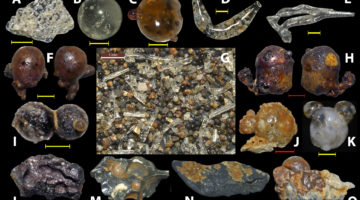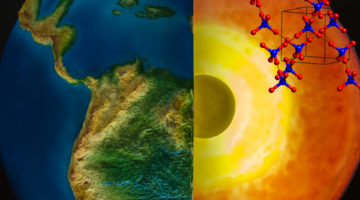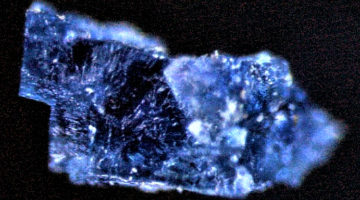Scientists analyzing a tiny carbon-rich pocket inside a meteorite found unexpected chemical signatures. Their findings are the first direct evidence that material from the outer solar system may have traveled inward long before planets formed, providing insight into the early solar system. Read more »
Study Concludes Glassy Menagerie of Particles in Beach Sands Near Hiroshima is Fallout Debris from A-Bomb Blast
Mario Wannier was methodically sorting through particles in samples of beach sand from Japan’s Motoujina Peninsula when he spotted something unexpected: a number of tiny, glassy spheres and other unusual objects. X-ray studies have provided evidence that they are A-bomb fallout from the destroyed city of Hiroshima. Read more »
Salt in the Amazon Air Comes from Local Fungi
The abundant salt in the atmosphere above the Amazon basin has long been attributed to the Atlantic Ocean. But now, using the Advanced Light Source, scientists have found that much of it originates much more locally: fungal spores in the rainforest. Pinpointing the origin will improve climate models and understanding of rainforest ecosystems. Read more »
Meteorites Suggest Galvanic Origins for Martian Organic Carbon
Nanoscale analyses of Martian meteorites suggest that organic carbon on Mars may have been formed by electrochemical reactions between briny liquids and volcanic minerals, as might occur in a galvanic cell. The study has major implications for astrobiology and could also shed light on the reactions that led to life on the early Earth. Read more »
Clues to the Solar System’s Original “Bricks and Mortar”
In comet dust, researchers discovered composite organic-inorganic mineral grains that are likely to be the original “bricks and mortar” of the solar system. “Forensic” samples preserved from the birth of the solar system allow investigations into the nature of the atomic and molecular ancestry of the terrestrial planets and life on Earth. Read more »![]()
![]()
From Moon Rocks to Space Dust: Berkeley Lab’s Extraterrestrial Research
Berkeley Lab has a well-storied expertise in exploring samples of extraterrestrial origin. This research—which has helped us to understand the makeup and origins of objects within and beyond our solar system—stems from long-standing core capabilities in structural and chemical analyses and measurement at the microscale and nanoscale. Read more »
Experiments at Berkeley Lab Help Trace Interstellar Dust Back to Solar System’s Formation
Experiments conducted at the Department of Energy’s Lawrence Berkeley National Laboratory (Berkeley Lab) helped to confirm that samples of interplanetary particles—collected from Earth’s upper atmosphere and believed to originate from comets—contain dust left over from the initial formation of the solar system. Read more »
Scientists Use Machine Learning to Span Scales in Shale
Machine-learning techniques have been used to integrate fine- and large-scale infrared characterizations of shale—sedimentary rocks composed of minerals and organic matter. Understanding shale chemistry at both the nano and mesoscale is relevant to energy production, climate-change mitigation, and sustainable water and land use. Read more »
Diamonds From the Deep: Study Suggests Water May Exist in Earth’s Lower Mantle
A new study suggests that water may be more common than expected at extreme depths approaching 400 miles and possibly beyond—within Earth’s lower mantle. The study explored microscopic pockets of a trapped form of crystallized water molecules in a sampling of diamonds from around the world. Read more »
Ingredients for Life Revealed in Meteorites
X-ray absorption spectroscopy and other techniques were used to measure the organic chemical components in a pair of meteorites that crashed to Earth in 1998. The study treads new ground in solar system history and asteroid geology, surfacing exciting possibilities for the existence of life elsewhere in Earth’s neighborhood. Read more »![]()
- « Previous Page
- 1
- …
- 3
- 4
- 5
- 6
- 7
- 8
- Next Page »









